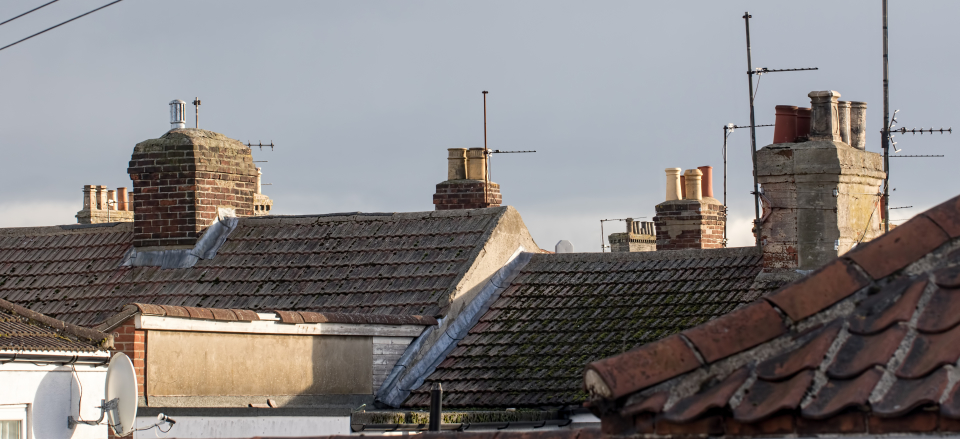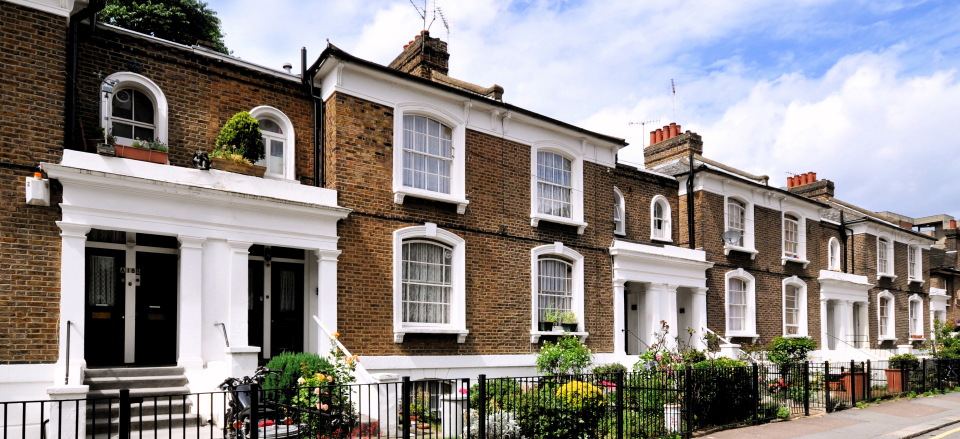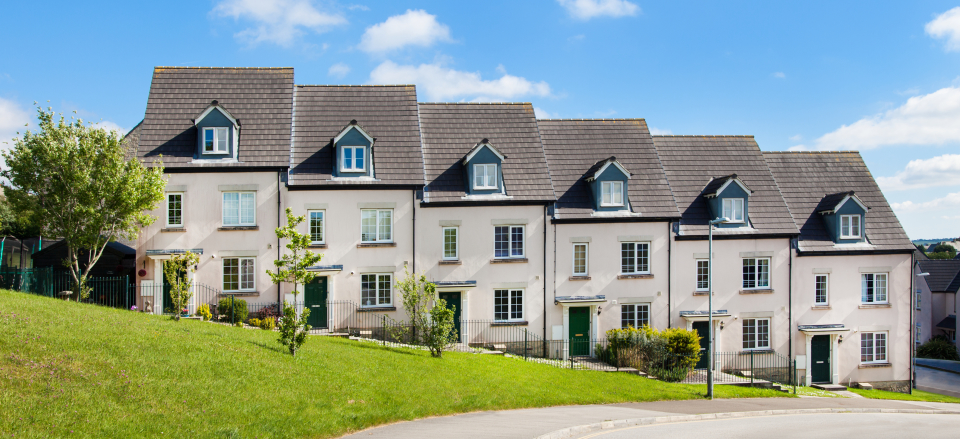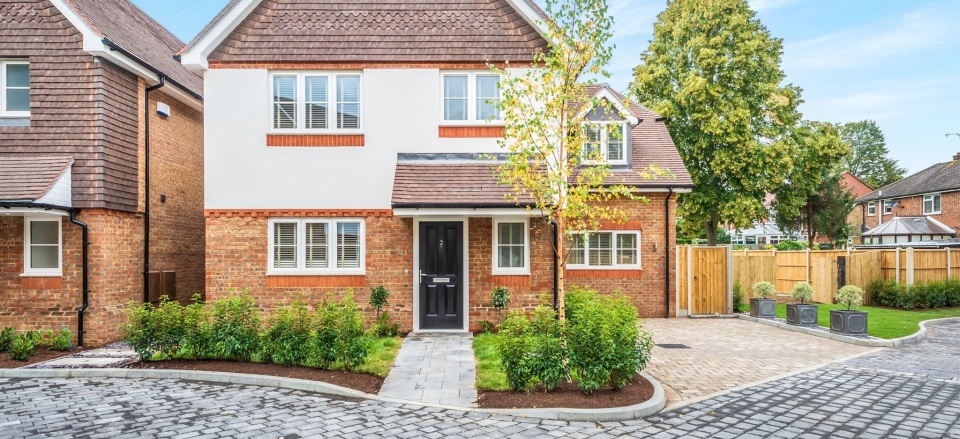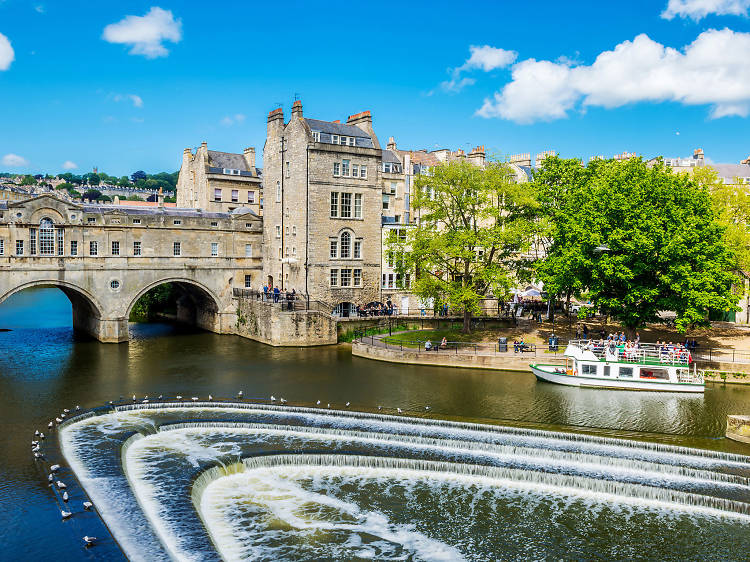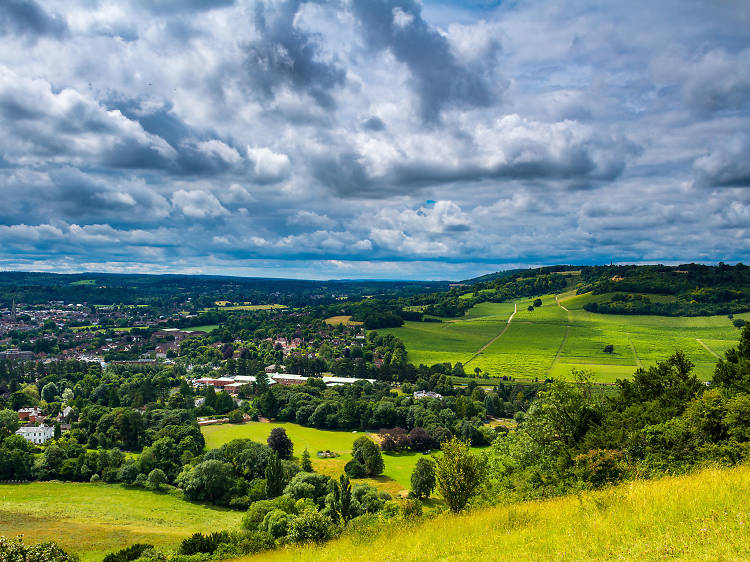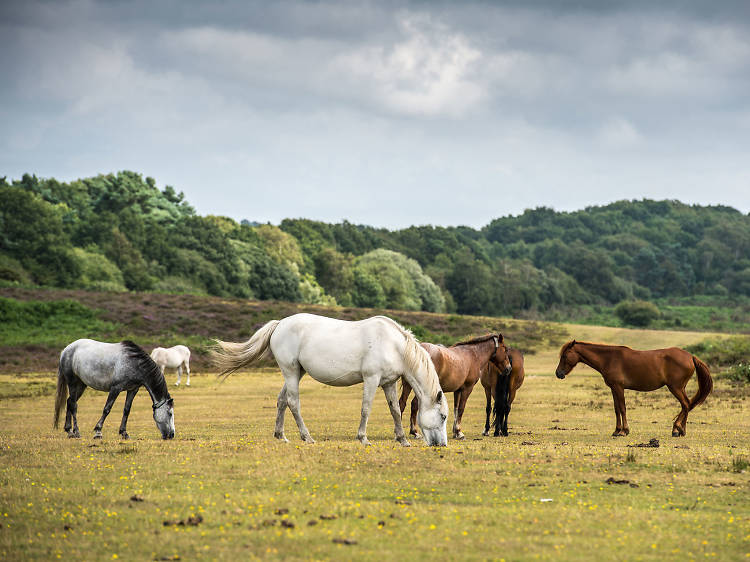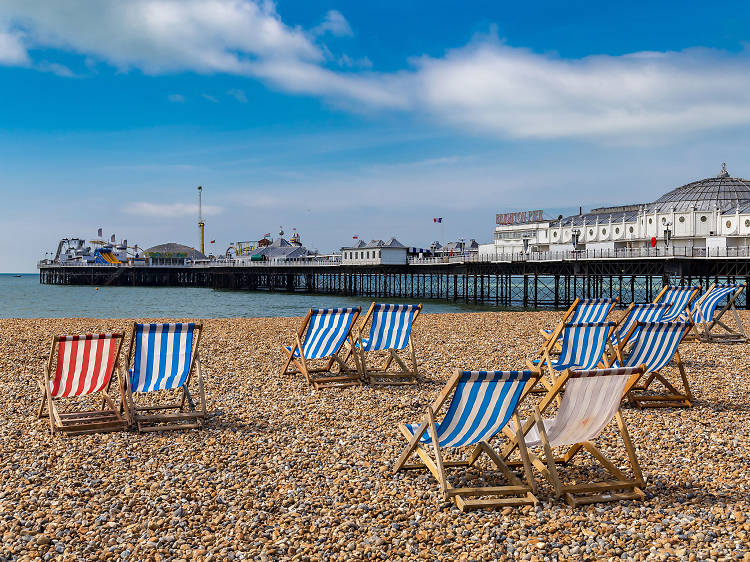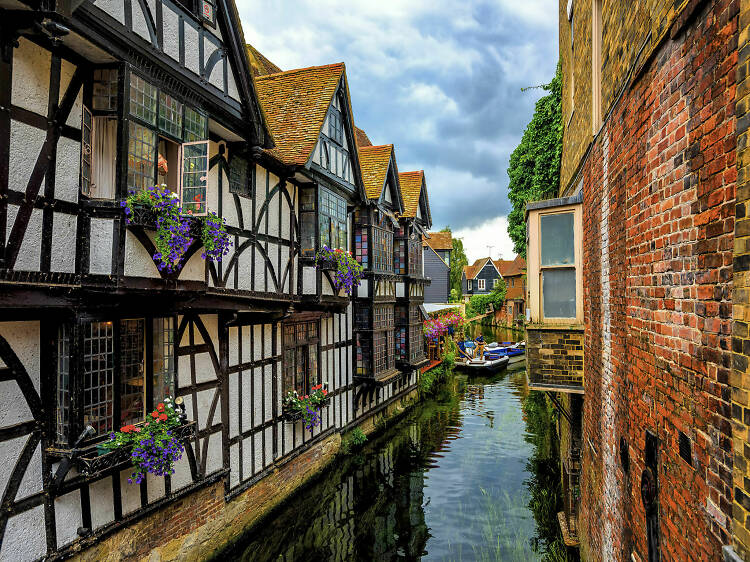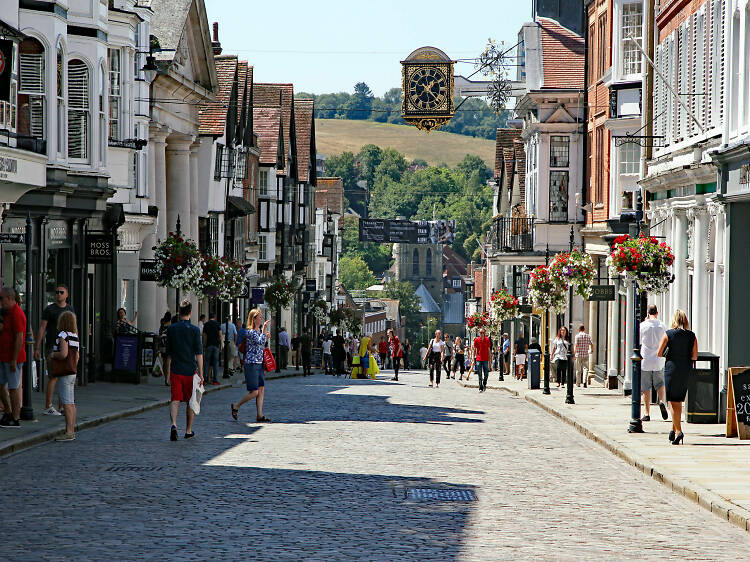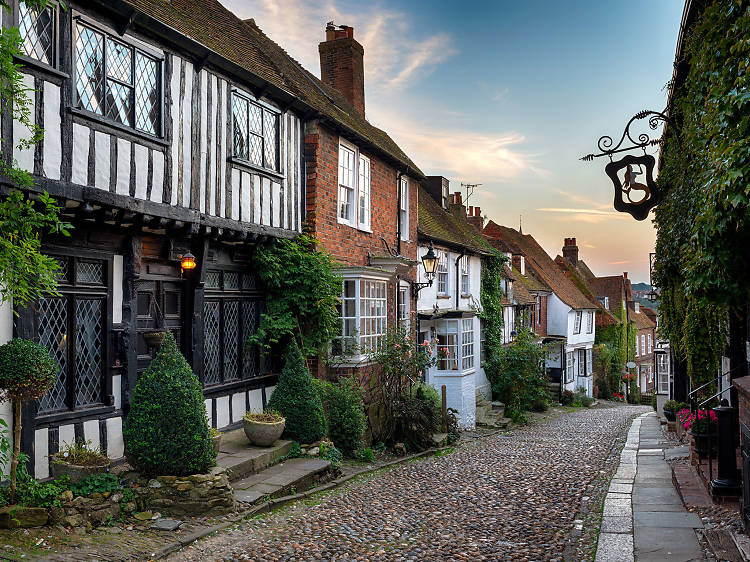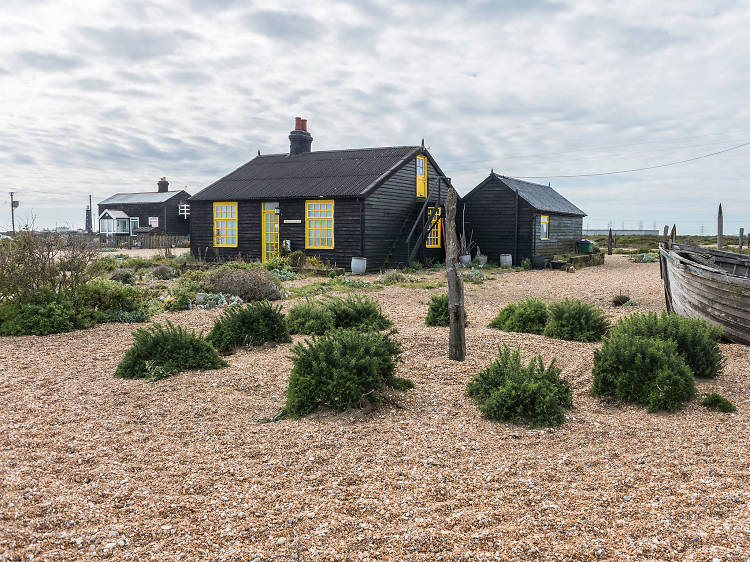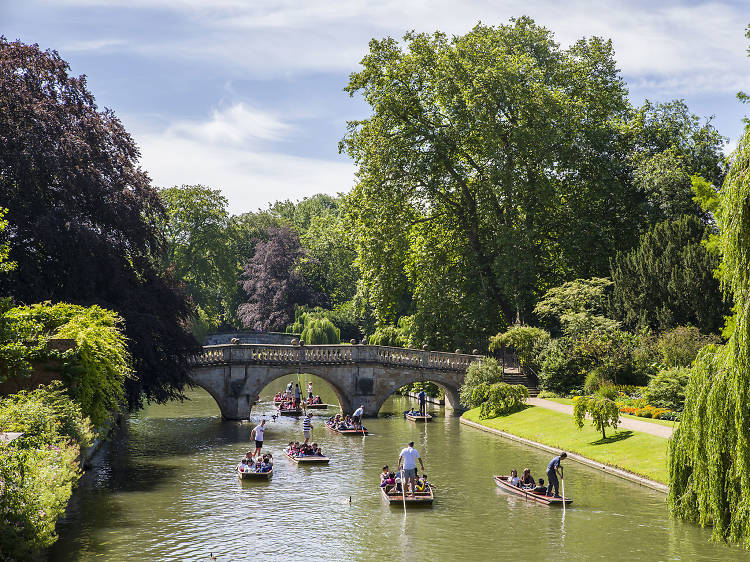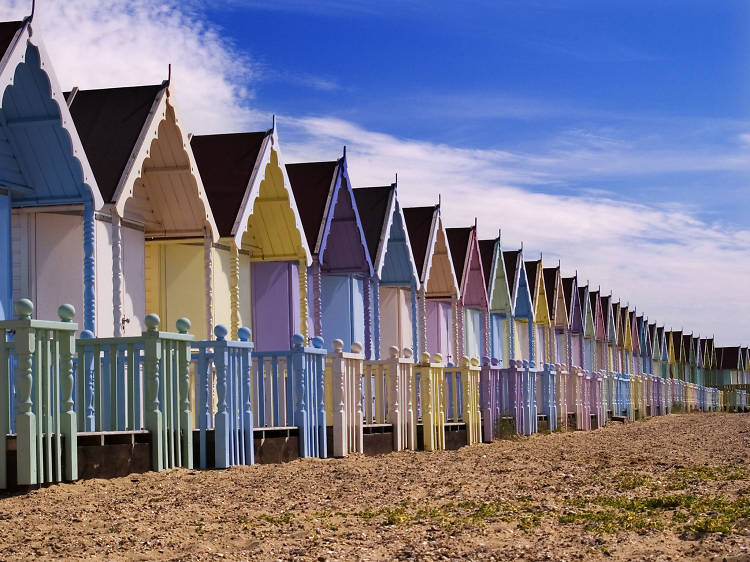First-time buyer numbers hit 12-year high
Thinking of taking your first step on the property ladder? You are not alone with first-time buyer numbers last year reaching their highest level since 2007, says a major lender.
First-time buyer numbers hit a 12-year high in 2019, accounting for more than half of all homes bought with a mortgage.
An estimated 353,436 people purchased their first property during the year, the highest level since 2007, according to Yorkshire Building Society.
While the total was broadly unchanged from 2018’s figure of 353,130, it was nearly twice as high as the 191,040 people who bought a first home in 2008, and continued to edge closer to the pre-financial crisis level of 400,870 recorded in 2006.
At 51%, first-time buyers also accounted for more than half of all home purchases made with a mortgage for the fourth consecutive year, up from just 38% in 2008.
Nitesh Patel, strategic economist at Yorkshire Building Society, said: “Even though the number of first-time buyers has stayed pretty much the same as last year, it is still encouraging to see first-time buyers top 350,000 for the second year in a row.
“They also represent over half of all homes bought with a mortgage, meaning the first-time buyer mortgage market share is at its highest since 1995, when they bought 53% of all mortgage-financed homes.”
Why is this happening?
A combination of factors has helped to boost first-time buyer numbers in recent years.
On the one hand, this group has been helped by an increase in lenders offering mortgages of 95% of a property’s value, reducing the size of the deposit first-time buyers need.
There has also been an increase in the availability of mortgages with terms of up to 40 years, which increases the affordability of monthly repayments.
At the same time, first-time buyers have also benefitted from significant government support, such as the Help to Buy equity loan scheme and Help to Buy ISA, as well as stamp duty relief on the first £300,000 of a property’s price.
Who does it affect?
Although London and the South East being the most expensive regions for first-time buyers, with typical first homes costing £415,618 and £264,097 respectively, they are also the most popular places for people getting on to the property ladder.
One in five people who bought their first home in 2019 did so in the South East, while 12% bought one in London, significantly higher than in other regions of the country.
First-time buyers accounted for 60% of all house purchases with a mortgage in London, despite putting down an average deposit of £131,000.
What’s the background?
Yorkshire Building Society said the slow year-on-year growth in first-time buyer numbers suggested they may now be plateauing due to affordability constraints.
It pointed out that property prices have grown faster than salaries over the past 12 years, meaning larger deposits are required to get on to the housing ladder.
Patel said: “These figures show the market may now have reached its peak and buying your first home still remains tough for many.”
Confidence returns to the property market
Sentiment towards the housing market looks positive as we hit 2020, according to the latest mortgage figures.
The housing market enjoyed a late autumn bounce with mortgage approvals for house purchase rising by 7% in November.
A total of 43,589 mortgages were approved by the high street banks for people moving home during the month, according to UK Finance.
There was also an increase in the number of loans approved for people remortgaging, with these rising by 12.7% year-on-year to 34,653 - the second highest level recorded in 2019.
The figures suggest confidence is returning to the housing market, despite the ongoing uncertainty surrounding Brexit.
Tomer Aboody, director of MT Finance, said: “It is positive for the market thatremortgages and mortgages for new purchases edged higher in November.
“This reflects sentiment in the market, which has been enhanced by a strong Conservative government coming in which will support the economy and housing growth.”
Why is this happening?
The final quarter of the year is traditionally a busy time for remortgaging with competition in the market intensifying as banks and building societies cut their rates in order to meet their end of year lending targets.
As a result, not only are homeowners who are sitting on their lender’s revert rate tempted to remortgage, but people who have taken out new mortgages during this period in previous years also look for new deals as their existing one comes to an end.
The increase in mortgage approvals for home-movers is slightly more surprising, as the housing market typically slows down in the run up to Christmas.
The figures suggest that potential buyers who had previously sat on their hands due to Brexit uncertainty may now be returning to the market.
Consumer confidence is likely to have increased further since the General Election, with the Conservative’s strong majority making it more likely that the UK will exit the EU according to the current timetable.
Who does it affect?
A return of confidence in the housing market is good news for everyone.
The market is currently stuck in a vicious circle in which the lack of confidence has caused existing homeowners to delay putting their properties on the market to trade up the ladder.
The situation creates a lack of choice for people who do want to go ahead with a purchase, which in turn makes them less likely to list their own property, exacerbating the shortage of homes for sale.
The current low level of transactions is particularly bad for first-time buyers, who need people to trade up so that properties at the bottom of the ladder become available.
What’s the background?
Confidence is only one factor that affects property transactions, with affordability also playing a key role.
Affordability levels have become increasingly stretched in southern markets in the past two years following strong house price growth.
As a result, these regions saw the slowest house price rises in 2019, according to our data.
By contrast, property remains much more affordable in northern parts of the country, with property values in Wales increasing at more than twice the national average during the past year, while North West England and Yorkshire and the Humber also saw strong gains.
The best Christmas events in London
Feel like getting festive this weekend? Here’s our guide to the best Christmas events in London.

It’s good news for all you Christmas enthusiasts, because the season to be jolly is right round the corner. We’re talking mulled wines in fake Bavarian huts, stuffing yourself with an excessive amount of mince pies and chowing down on a festive pig in blankets sandwich without judgement (okay, maybe a little).
But beyond the sweet treats, it’s all the events that make this time of the year as special as it is. Whether you're perusing a Christmas market or treating yourself to a warming carol concert, there are all sorts of things to get up to this Xmas and because we're feeling merry, we've pulled together some of our top festive picks.
Classic Christmas events on this week
Christmas at Kew Gardens
Kew’s incredible botanical gardens will be undergoing another magnificent seasonal makeover in 2019, as Christmas at Kew lights up the space’s iconic buildings and the weird and wonderful plants that call it home.
Southbank Centre Winter Festival
The Southbank Centre Winter Festival returns is back for 2019 with another sparkling programme of festive shows and performances, family fun and music.
Skate at Somerset House
Now in its twentieth year, the arrival of the ice rink in Somerset House’s grand eighteenth-century courtyard is something of a festive institution. The 900-square-metre outdoor rink returns to the spot from November 13 to January 12, and is a great way to spend the day no matter how impressive your skating skills are.
Plan an amazing Christmas in London
It's beginning to look a bit like Christmas in London. These festive events, markets and cosy pop-ups will provide enough festive cheer to see you through the rest of the year.
Almost as soon as the temperature drops and the clocks go back, London is transformed into a wintery wonderland. Ice rinks appear in squares, on rooftops and outside London icons while the city glitters with Christmas lights and creatively decorated trees. Suddenly, you can fill your free time sipping hot booze in kitsch pop-up bars (like this Miracle on Ninth Street one), wandering through an Enchanted Woodland or following your nose around an intricate gingerbread city.
Of course there are pantos, parties and countless Christmas markets – the Southbank Winter Market and Hyde Park’s enormous Winter Wonderland need no introduction – but the point is, London is stuffed like a stocking full of magical things to do at Christmas.
Oh, and talking of gifts, we’ve got Christmas shopping in London all wrapped up too – check out our 2019 Christmas gift guide and our pick of Christmas shops in London. Trying to cut back or give back? We’re with you. Find out how to have a sustainable Christmas in the capital this year.
Housing market expected to enjoy a post-election bounce
Housing market activity continued to decline in November but estate agents expect a rebound following the General Election.
Demand from potential buyers, instructions to sell and agreed sales all continued to worsen during the month, as people put major decisions on hold, according to the Royal Institution of Chartered Surveyors.
But property professionals are more upbeat about the market’s prospects in the new year, with 12-month sales expectations reaching their highest level since the early part of 2017.
Simon Rubinsohn, RICS chief economist, said: “Confidence is critical to a well-functioning housing market and whatever happens in the general election, it is important that the new government provides reassurance both over the stewardship of the economy and the ongoing challenges around Brexit.”
Why is this happening?
Markets hate uncertainty and the property market is no exception, with potential buyers currently facing a triple whammy of uncertainty over the Government, Brexit and the economy.
But the result of the General Election will not only end the political uncertainty, but it will also offer more clarity on when the UK is likely to exit the EU.
This is expected to release some pent-up demand from people who have put moving plans on hold for months or even years while they have waited to see when Brexit will happen and what impact it is likely to have on the economy.
Who does it affect?
The lack of activity in the housing market has left the average number of homes estate agents have on their books close to a record low of 41.
The situation creates a vicious circle in which existing homeowners who may be considering trading up or down the property ladder put off listing their own home due to a lack of choice for their next move, which in turn intensifies the current shortage of stock for sale.
What’s the background?
The good news is that RICS expects the situation to begin to improve going forward.
Estate agents expect sales levels to start to pick up over the coming three months, while optimism about the number of homes changing hands 12 months from now has reached its highest level for nearly three years, with a solid increase expected in all regions.
Price growth is also expected to recover across the country, with Northern Ireland and Wales seeing the strongest gains.
Top three takeaways
- Housing market activity continued to decline in November but estate agents expect a rebound following the General Election
- Demand from potential buyers, instructions to sell and agreed sales all continued to worsen as people put major decisions on hold
- Looking forward, property professionals’ 12-month sales expectations have reached their highest level since the early part of 2017
Private landlords sell up following tax changes
The number of homes available in the private rental sector has shrunk by more than 100,000 since tax changes impacting landlords were introduced.
The exodus comes after the Government began restricting the amount of mortgage interest tax relief buy-to-let investors could claim.
Since the change, which is being introduced in phases, was first introduced in April 2017, 103,900 more buy-to-let properties have been sold than those that have been purchased, according to estate agent Savills, which analysed mortgage data.
Lawrence Bowles, senior research analysts at Savills, said: “With tax relief on landlords’ mortgage interest shrinking, it’s become harder to make a profit from a mortgaged buy-to-let property.”
The situation means that demand in the private rental sector is already outstripping supply.
Why is this happening?
Since April 2017, the Government has been steadily reducing the amount of mortgage interest tax relief landlords can claim from 100% to just 25% now.
The relief will be phased out completely in April next year, when it will be replaced by a 20% tax credit for mortgage interest.
The move not only leaves landlords facing higher tax bills, but it has also pushed some basic rate taxpayers into the higher rate band.
The combined changes have made it less profitable to be a landlord, leading to many investors selling up.
Who does it affect?
The situation is bad news for people who rent in the private sector, which is already struggling to keep pace with demand.
The Royal Institution of Chartered Surveyors has reported that the number of new homes coming on to the market to let has been in steady decline, while the number of people looking to rent a home has reached its highest level since the end of 2016.
It warned that the situation was putting upward pressure on rents.
But the fall in buy-to-let landlords has been better news for first-time buyers, as the two groups typically compete for properties at the bottom of the housing ladder.
What’s the background?
Savills said the number of landlords selling properties was most acute in southern regions, such as London and the south east, where property prices are higher and yields are lower.
They are instead purchasing properties in northern regions where the higher yields cover their increased costs.
But high house prices in the south means demand for rental property is greater there as it takes people longer to get on to the housing ladder.
Top 3 takeaways
- The number of homes available in the private rental sector has shrunk by more than 100,000 since tax changes impacting the sector were introduced
- The exodus comes after the Government began restricting the amount of mortgage interest tax relief buy-to-let investors could claim
- Demand in the private rental sector is already outstripping supply.
Help to Buy hotspots revealed
Wakefield in Yorkshire is England’s top Help to Buy hotspot with more people there using the scheme to buy a home than in any other local authority.
A total of 2,732 properties have been purchased in Wakefield, where the average new-build home costs £221,740, using the equity loan scheme since it was first launched in 2013.
It was followed by Wiltshire, where 2,725 equity loans have been advanced, and County Durham at 2,515, with Central Bedfordshire and Leeds completing the top five.
Wakefield was also the most popular area in which the scheme has been used during the past 12 months, followed by Central Bedfordshire and Tower Hamlets in London.
The findings come after separate research showed many first-time buyers were using the Help to Buy equity loan to buy larger, more desirable homes than they would otherwise be able to afford.
Why is this happening?
The Help to Buy equity loan scheme enables people to purchase a new-build property with just a 5% deposit with the Government topping this up with a five-year interest-free equity loan.
While the initiative is often seen as helping first-time buyers, it can be used by anyone trading up the property ladder.
Laura Howard, consumer expert at Zoopla, said: “Whilst it might be presumed that first-time buyers only use Help to Buy in markets with stretched affordability such as London, our analysis shows that its popularity actually spans the entire country.”
In fact, average house prices for the top 10 most popular locations in which the help to buy scheme was used in the past 12 months ranged from £196,783 in County Durham to £520,408 in Barnet in London.
Who does it affect?
As well as helping first-time buyers purchase a home, research shows the Help to Buy scheme has also enabled them to leapfrog the first rung of the property ladder and buy a larger, typically three-bedroom, property.
By entering their household income, preferred mortgage term and interest rate, it shows the maximum property value they could buy, how much they would need to save for a 5% deposit, estimated monthly mortgage repayments and monthly charges on the equity loan once the interest-free period comes to an end.
What’s the background?
While the Help to Buy equity loan scheme has helped thousands of people to get on to the property ladder, it is not suitable for everyone.
Potential buyers considering using the initiative need to weigh up the pros and cons, and while it may enable them to afford a bigger home, they are limited to purchasing a new-build property, while they can only use certain lenders.
Studies also suggest Help to Buy has inflated the cost of new-build properties, with first-time buyers in some areas paying a premium of up to 22% to use the equity loan scheme.
Remortgaging soars as homeowners cash in on competition among lenders
The number of people remortgaging has soared to a two-year high as homeowners take advantage of lenders’ end-of-year price war to lock into a good deal.
A total of 37,769 mortgages were approved for people switching to a new deal in October, 12.7% more than in the same month of last year, according to industry body UK Finance.
Mark Harris, chief executive of mortgage broker SPF Private Clients, said: “As we head towards the end of the year, and lenders jostle for what business there is out there, there are some incredible deals on the market to attract borrowers.”
There was also an increase in the number of mortgages approved for house purchase, with these rising 3% year-on-year to 46,631, despite the uncertainty caused by the General Election.
Why is this happening?
The final quarter is traditionally a busy time for remortgaging as banks and building societies try to entice homeowners with competitive deals in a bid to meet their annual lending targets by the end of the year.
This situation not only encourages people who are sitting on their lenders’ standard variable rate to remortgage, but it also means a higher volume of mortgages tend to expire during this period, due to people previously taking out fixed term deals in the run up to the end of the year.
The surge in remortgaging typically helps to offset a more subdued market for lending to people buying a new home, with house-hunters typically putting moving plans on hold until after Christmas
Who does it affect?
End of year competition among lenders is great news for anyone looking to remortgage.
Halifax is currently offering a two-year fixed rate mortgage of 1.08% for people with a 40% deposit, while NatWest is offering a two-year deal of 1.25% for those with a 25% deposit.
Rates ate only slightly higher for homeowners who want to fix for five years, with Virgin Money offering a deal of 1.46% for people borrowing 65% of their home’s value.
Nationwide, Halifax, NatWest and Royal Bank of Scotland all have five-year fixed rate loans with rates below 1.6%.
What’s the background?
The housing market has shown signs of enjoying a slight autumn bounce, although the lift has been more muted than in previous years.
Subdued transaction levels are partly due to the current uncertainty caused by both Brexit and the General Election.
But high house prices and stretched affordability in many areas are also acting as a drag on the market, particularly in southern regions.
Even once Brexit is finalised, activity levels are not expected to pick up significantly, with house price growth also expected to remain low.
Top 3 takeaways
-
The number of people remortgaging has soared to a two-year high as homeowners take advantage of lenders’ end of year price war
-
A total of 37,769 mortgages were approved for people switching to a new deal in October, 12.7% more than in the same month of last year
-
There was also an increase in the number of mortgages approved for house purchase, with these rising 3% year-on-year to 46,631
Gardens and kitchens on a par for home-hunters
Half of Britons think a well-designed garden is as – or more – important than a designer kitchen or bathroom when it comes to their quest for a perfect home.
House-hunters are prepared to pay a premium of nearly £15,000 for a garden when purchasing a property, and put the importance of outside space up there with a top-end kitchen or bathroom.
A further 40% would consider hiring a professional garden designer in order to transform their outside space, according to research by Zoopla and the Society of Garden Designers.
Gardens are considered to be so important that 74% of homeowners have either already spent money on their outside space or would consider doing so in a bid to increase the value of their property.
At the same time, house-hunters are prepared to pay a premium of £14,448 to purchase a home with a garden.
Sarah Morgan, chair of the Society of Garden Designers, said: “We know from our members that having a garden designed by a professional designer can add significant value to a property. But, quite apart from the overall ‘wow’ factor, a good garden design can also add something really special to a home.”
Why is this happening?
Both buyers and renters put a high emphasis on having outdoor space, with 86% of both groups saying having a garden was very or extremely important.
People are also prepared to spend significant sums to create their dream garden, with homeowners willing to splash out an average of £7,339.
But the outlay does not end there, with the typical person spending £678 a year maintaining their garden.
Which regions value a garden most?
People living in the south east are prepared to pay the biggest premium for a property with a garden at an average of £21,925, followed by house-hunters in the north west at £18,425.
Those in the south east are also most likely to rate having a garden as being important at 91%.
At the other end of the scale, buyers in Yorkshire and Humber will pay the smallest premium for outside space at an average of £9,068, despite 84% of people rating having a garden as being important.
Homeowners in the East of England are prepared to spend the most in order to transform their outdoor space into their dream garden at £10,882, nearly double the amount people in Wales are prepared to spend at £5,832.
Regional breakdown of garden spending
| Region |
Average premium willing to pay for a garden |
Average current spend per year |
Average spend transforming current garden |
|
South East |
£21,925 |
£812 |
£7,822 |
|
North West |
£18,425 |
£518 |
£5,860 |
|
East of England |
£13,974 |
£753 |
£10,822 |
|
London |
£13,388 |
£554 |
£7,434 |
|
East Midlands |
£12,803 |
£734 |
£8,440 |
|
South West |
£11,935 |
£674 |
£6,899 |
|
Wales |
£11,268 |
£733 |
£5,832 |
|
North East |
£10,569 |
£732 |
£7,257 |
|
West Midlands |
£10,552 |
£731 |
£7,812 |
|
Scotland |
£10,207 |
£700 |
£6,646 |
|
Yorkshire and Humber |
£9,068 |
£619 |
£6,435 |
|
Britain |
£14,448 |
£678 |
£7,339 |
What’s the background?
When it comes to creating a dream garden, having somewhere to sit and relax was ranked as the most important feature, cited by 36% of people.
It was followed by having south-facing outdoor space or a design that allowed the maximum amount of sunlight throughout the day, which was key for 15% of people.
Both of these features were considered to be more important than having somewhere for children to play or space for pets, cited by 12% and 7% respectively.
Around 8% of people wanted flowers or shrubs to be part of the design, while 6% wanted somewhere to entertain and 4% of people wanted to be able to grow their own fruit and vegetables.
But water features appear to have fallen out of fashion, with only 0.4% of people considering this an important feature of a garden design.
The 9 most important design features of a garden according to Brits:
- Somewhere to sit and relax (36%)
- Maximum sunlight throughout the day / south facing (15%)
- Somewhere for the children to play (12%)
- Flowers / shrubs (8%)
- A space for pets (7%)
- Somewhere to entertain (6%)
- Growing my own fruit/vegetables (4%)
- Extra storage space/shed (2%)
- A water feature (0.4%)
Top 3 takeaways
- Half of Britons think a well-designed garden is as important or more important than a designer kitchen or bathroom
- A further 40% would consider hiring a professional garden designer in order to transform their outside space
- House-hunters are prepared to pay a premium of £14,448 to purchase a home with a garden
15 Best Day Trips From London When You Need A Break From The City
The best day trips from London
Looking to get out of the city for a few hours? Here’s the definitive list of best day trips from London, featuring spa cities, seaside towns and adventures in the great British countryside
Sometimes the best way to truly appreciate a place is to leave it for a short while. We suspect that's the case with London – much as we adore life in the Big Smoke, we also relish the occasional change of scene.
Helpfully, England is really quite small, which means getting from the city to the coast is a doddle – grab a coffee, hop on the train and you'll be breathing in fresh, salty sea air before you know it.
Whether you're in the mood for pony-filled forests, picture-postcard towns or pebble beaches, here are fifteen sweet spots, complete with cute pubs and ace restaurants – and all close enough to the capital to get there and back in a day.
1. Whitstable
It’s hard to think of a lovelier seaside spot than Whitstable. Kick off a day there at Blueprint Coffee and Books with a pot of something strong and ethically sourced (and maybe a mini orange-and-rosemary bundt cake). Next, rent a bike from Whitstable Cycle Hire and pedal your way along the five-mile seafront Oyster Bay Trail. And for lunch? Oysters, natch – watch them being shucked in front of you at The Forge. Stay on the beach for a drink as the sun sets: Whitstable is one of the few in the UK with a pub, the Old Neptune, right on the shingle.
How far? 61 miles
Get there one hour 20 minutes by train from London Victoria or one hour 10 minutes from St Pancras International to Whitstable; around one hour 40 minutes by car.
2. Deal
It doesn’t get as much attention as Margate and Whitstable, but with its tidy rows of Georgian townhouses, quirky independents and thriving Saturday market, Deal ticks all the day-trip boxes. Start at Deal Castle (built by Henry VIII as part of an ambitious chain of coastal forts), then treat yourself to lunch at 81 Beach Street or Victuals & Co. Parisian-style bottle shop Le Pinardier is great for stocking up on gluggable goodies, and make sure you stop by gallery-cum-homewares boutique Taylor-Jones and Son, where Delilah the sheepdog will welcome you with open paws.
How far? Just over 80 miles
Get there one hour 20 minutes by train from London St Pancras International; around two hours by car.
3. Margate
The Turner Contemporary opening in 2011 was the long-neglected Margate’s invitation to the ball. Today, the Kent coast’s most famous Cinderella story is awash with cold-brew coffee and craft beer, with just enough salty charm to still give it an edge. Start at the Turner, then mosey over to retro theme park and roller-disco Dreamland. Once the effects of the Waltzer have worn off, head to Hantverk & Found for a lunch of the freshest seafood and natural wines. Spend the rest of the afternoon shopping: browse immaculate vintage piece in Breuer & Dawson, and stock up on seaweed-based skincare at Haeckels.
How far? 76 miles
Get there one hour 25 minutes by train from London St Pancras International; around two hours by car.
4. Bath
Water wonderful day awaits you here! Start as you mean to go on with a tour of the baths the Romans built (no paddling allowed), before making a splash in the Thermae Bath Spa – the rooftop pool has stunning views of the city. Once you’ve dried off, make like Jane Austen and stroll along the Royal Crescent, then try on some reproduction Georgian garms at the Fashion Museum. Peckish? Sally Lunn’s teahouse is home to the Sally Lunn Bun, a kind of sweet brioche bap – for a Bath take on the cream tea, order one toasted and spread with strawberry jam and clotted cream.
How far? 115 miles
Get there one hour 30 minutes by train from London Paddington; two hours 30 minutes by car.
5. Box Hill
Biking to green and pleasant Surrey is a wheely nice way to spend a Sunday (sorry) – plus, Box Hill was part of the 2012 Olympic road-cycling route. Start in Richmond Park and pedal down past Hampton Court – it should take you about two hours. After a 1.6 mile climb and some hairpin bends (easier than it sounds!), you’ll be rewarded with stunning views of the North Downs from the top of Box Hill itself. Grab a slice of cake from the National Trust café, but save space for lunch at The Tree, which serves homemade pies and crumbles. Your last stop is Box Hill and Westhumble station, where you can load your bikes on to a train back to Waterloo. Whewf!
How far? 30 miles
Get there by bike (obviously). Plan the route carefully before you set out, and take a map and a puncture repair kit, plus water and snacks.
05. The New Forest
A trip to the New Forest is about as close as you can get to going on safari without buying a plane ticket. As you make your way down dappled lanes and across the heather-covered heath you’ll be watched the famous ponies, which have grazed there for thousands of years, plus free-ranging Highland cattle and pigs hoovering up fallen acorns. Don’t fancy being stuck in the car all day? Hire a two-seater electric Twizzy buggy to explore in, or book a beginners’ hack at one of the stables. Don’t forget to make time for a proper ploughman’s lunch at the Royal Oak in Fritham.
How far? 90 miles
Get there one hour 30 minutes by train from London Waterloo to Brockenhurst; around two hours by car. Just remember that animals, not drivers, have right of way.
08. Brighton
If Brighton were a stick of rock, it would have GOOD TIMES! running right the way through it. With its perfect pebble beach, wall-to-wall live music venues and buzzing LGBT+ scene, there’s nowhere like it for topping up your Vitamin Sea levels. Start by dodging seagulls on the Palace Pier, then shop up a storm in the Laines, which are packed with independent boutiques, record stores and vegan eateries. Sit down to a zero-waste late lunch at Silo, and finish up with a couple of pints in the Brighton Beer Dispensary, which champions small Sussex breweries like the Hand Brew Co.
How far? A little over 50 miles
Get there one hour by train from London Victoria, Blackfriars or London Bridge; around two hours by car.
09. Canterbury
In Chaucer’s day this was where people came for a big old knees-up. Today its default is a little more sedate, but a large student population means there’s still a pleasingly rowdy edge. Kick things off with a leisurely stroll down the King’s Mile, home to boutiques a-plenty. Lunch-wise you’re spoilt for choice, from gourmet Scotch eggs with slaw and fries at Pork & Co, bento boxes at Tamago or pizza straight from the oven at indoor farmers’ market The Goods Shed. Round off your very own Canterbury tale with a visit to the Beaney House of Art and Knowledge, which features one of the world’s most important collections of cow paintings and an Egyptian mummified cat.
How far? 61 miles
Get there one hour by train from London St Pancras International; around one hour 30 minutes by car.
10. Guildford
Heads up, horror fans: Guildford’s cathedral starred in cult bone-chiller ‘The Omen’. That being said, everything else about Surrey’s county town is bucolic in the extreme: if it’s sunny you can lounge by the water at pretty Dapdune Wharf, or actually get in it at the Guildford Lido. Lunch on locally-sourced nacho boxes at Burrito Loco, before checking out the 400-year-old Star Inn. Still thirsty? Hop on a train to tour the nearby Hogs Back Brewery.
How far? 31 miles
Get there 30 minutes by train from London Waterloo; around one hour by car.
11. Rye
With its antique shops and higgledy-piggledy cobbled lanes, Rye feels like a little piece of the Cotswolds on the coast. After a browse in The Tiny Book Store (does what it says on the tin), treat yourself to a seafood lunch surrounded by lobster pots at Globe Inn Marsh, followed by Sussex real ale or a glass of local wine at The George Tap – the Chapel Down vineyard is just up the road and well worth a visit. Ten minutes away are the pillowy dunes of Camber Sands: roll your trousers up and splash through the shallows, take a kite for a spin or just park your towel and stretch out.
How far? 79 miles Get there by car.
Get there one hour 10 minutes by train from London St Pancras International, with a change at Ashford; around two hours by car.
11. Dungeness
Dungeness’s shingly, shipwreck-dotted beach is so spookily empty that it’s often described as Britain’s only desert (though the Met Office refuses to recognise it as such, the party-poopers). But look a little closer and there’s plenty going on. It’s a nature reserve, for one thing – follow the two-mile trail around RSPB Dungeness for the chance to glimpse glossy ibises and marsh harriers. Come lunchtime, queue up at the famous Dungeness Snack Shack: they’ll serve you their catch of the day in a warm bun, lobster and crab rolls or smoked cod chowder. Finally, go in search of the huge concrete ‘sound ears’, which date from the First World War and were designed to listen out for planes.
How far? 86 miles
Get there one hour by train from London St Pancras International to Folkstone, with a one hour 30 minute bus ride to Dungeness; around two hours by car.
12. Cambridge
Smaller, quieter and (whisper it) prettier than Oxford, Cambridge has its own language: bumps, backs, quads. Start your day with a visit to the Fitzwilliam Museum, then refuel at Fitzbillies and buy a box of the sticky Chelsea buns to take home. Spend a couple of hours wandering around the colleges and King’s Chapel before taking to the river for a spot of punting: behatted guides will do the hard work, or you can hire a boat of your own (beware: it’s trickier than it looks). Come tea time, head for Grantchester and feast on scones in The Orchard Tea Gardens, just like poet Rupert Brooke.
How far? 64 miles
Get there 45 minutes by train from London King’s Cross, or one hour 10 minutes from London Liverpool Street; around two hours by car.
13. Mersea Island
Attached to the mainland by a causeway that floods (and pub quizzers, take note: this is the UK’s most easterly inhabited island), Mersea feels properly, peacefully remote at high tide. The big draw is The Company Shed, which serves seafood platters that pull in crowds from all over the country every weekend. It’s BYOB – bring your own bread – and they don’t take bookings, so get there before noon to make sure you can feast on prawns, smoked fish, oysters and dressed crab. Speaking of which, catch-and-release crabbing is encouraged – there are specially marked areas near the water, and shops selling the kit. Or you can book a boat trip around the bay.
How far? 69 miles
Get there one hour by train from London Liverpool Street to Colchester, then a 45 minute bus to Mersea Island; around two hours by car. Don’t forget to check the tide timetable before you set off...
14. Chichester
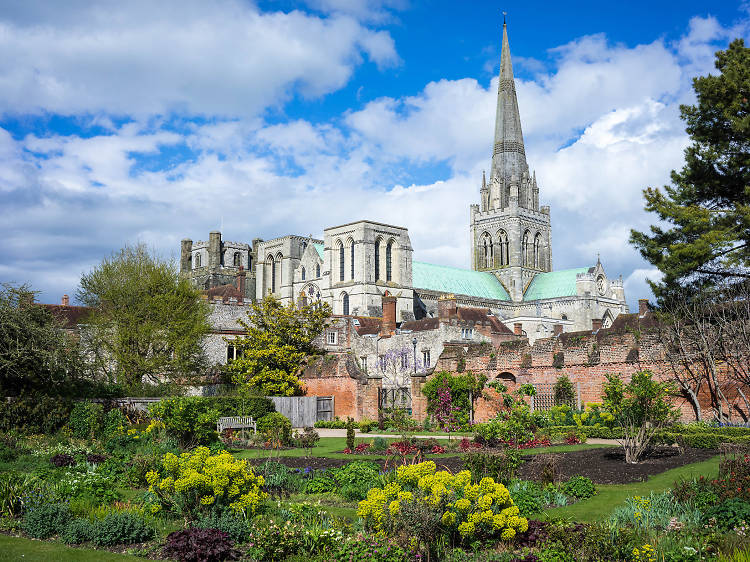 Dinky, pastel-coloured Chichester looks like it’s been built of macarons – but it’s more than just a pretty face. Start at the Norman-meets-Gothic cathedral before moving onto the Pallant House Gallery, home to brilliantly curated exhibitions, a first-class bookshop and a courtyard cafe that gives Rochelle Canteen a run for its money. Some of the best bits of Sussex are an easy drive (or, if you’re feeling full of beans, a slightly less easy bike ride) away, from the Goodwood Estate to West Dean Gardens and the gorgeous sandy beach at West Wittering.
Dinky, pastel-coloured Chichester looks like it’s been built of macarons – but it’s more than just a pretty face. Start at the Norman-meets-Gothic cathedral before moving onto the Pallant House Gallery, home to brilliantly curated exhibitions, a first-class bookshop and a courtyard cafe that gives Rochelle Canteen a run for its money. Some of the best bits of Sussex are an easy drive (or, if you’re feeling full of beans, a slightly less easy bike ride) away, from the Goodwood Estate to West Dean Gardens and the gorgeous sandy beach at West Wittering.
How far? 80 miles
Get there one hour 30 minutes from London Vicotoria; around two hours by car. Car is best, so you can really explore.
15. Stratford-upon-Avon
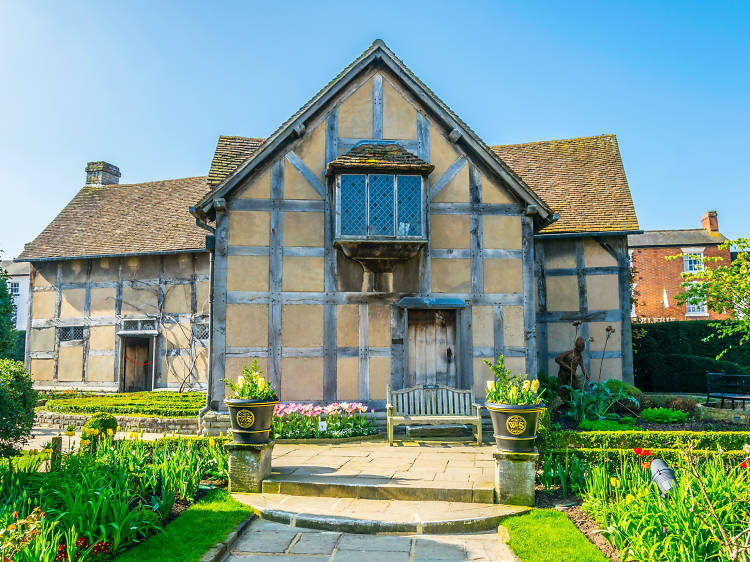 The Bard, of course, is the big draw here, and Shakespeare’s house, his wife Anne Hathaway’s cottage and the RSC’s home theatre are all must-sees. But Stratford’s more than just a Tudor Disneyland, you know. Take a boat tour of the canal basin to find out more about the West Midlands’ waterways, refresh yourselves in the Grade II-listed Old Thatch Tavern, stop for a scoop of Eton Mess ice cream at Hooray’s British Gelato Kitchen and pick up some local Berkswell to take home from posh cheesemonger Paxton & Whitfield (sorry, fellow travellers).
The Bard, of course, is the big draw here, and Shakespeare’s house, his wife Anne Hathaway’s cottage and the RSC’s home theatre are all must-sees. But Stratford’s more than just a Tudor Disneyland, you know. Take a boat tour of the canal basin to find out more about the West Midlands’ waterways, refresh yourselves in the Grade II-listed Old Thatch Tavern, stop for a scoop of Eton Mess ice cream at Hooray’s British Gelato Kitchen and pick up some local Berkswell to take home from posh cheesemonger Paxton & Whitfield (sorry, fellow travellers).
How far? 104 miles
Get there two hours 15 minutes by train from London Marylebone; around two hours by car.

